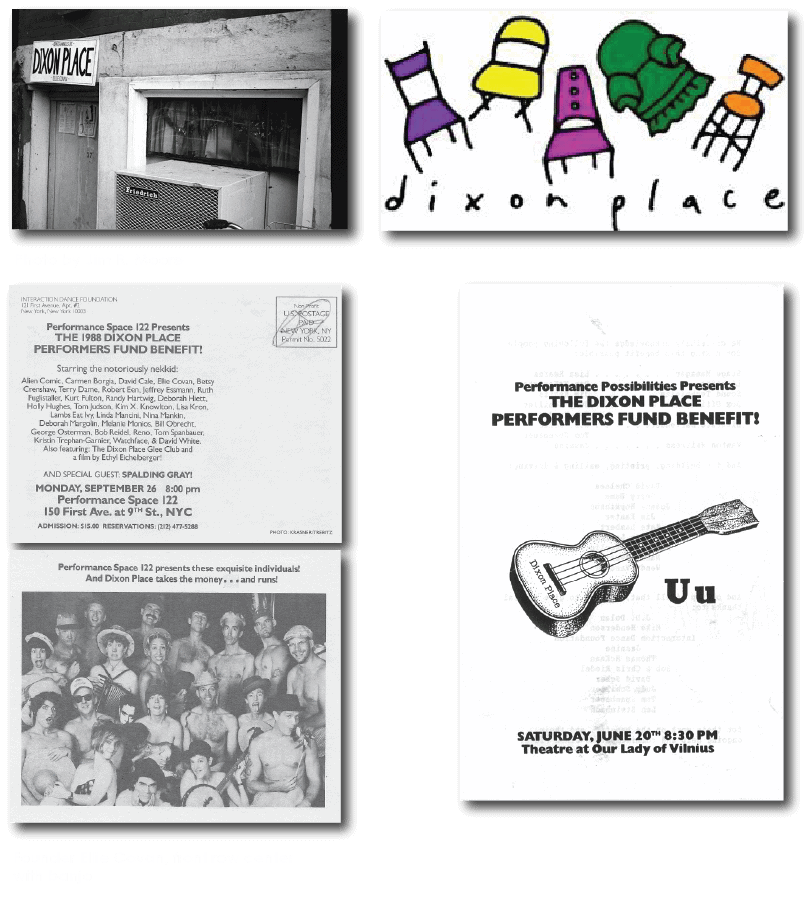


Dixon Place grew out of a salon held in founder Ellie Covan’s Paris apartment in the summer of
1985. At a dinner party she hosted for a few women friends, the group listened as each one read a
short story. Ellie had such a good time that she began to repeat the experience weekly, with a
variety of performing and visual artists eventually participating in addition to the authors who were
her original focus. Her apartment was in a building belonging to the Dixon publishing family which
inspired the name of her recurring forum.
After moving to New York’s East Village the following year, Ellie introduced the venture to New York
City in the living room of her storefront home on East First Street. She set up an assortment of chairs,
stools, and couches for her audience and sold drinks and snacks from her kitchen, supplementing
the $3 admission charge to help cover her expenses. She began with readings in September of
1986, but by the next month, Ellie was booking performance. Watchface was introduced to her
audiences on First Street during her first October there. Over the following years, Dixon Place
became an artistic incubator committed to presenting original works of theater, dance, music,
puppetry, circus arts, literature, and visual art at all stages of development. Covan’s goal was to
establish Dixon Place as a local haven to inspire and encourage diverse artists to take risks and
generate new ideas.
Besides the broad range of performers and artists that visited her living room, Ellie as a personality
was a large part of Dixon Place’s success. She was a charming and welcoming hostess, famous
for her enthusiastic and often zany introductions of that evening’s presentation. She frequently
started the evening off with a rousing tune played on her ukulele or accordion and held Bingo
games for real prizes, such as meals at neighborhood restaurants, with the audience during
intermissions.
After over five years of fearlessly hosting a variety of performers in her home, Ellie and Dixon Place
moved to a larger loft space on the Bowery to accommodate her growing audience. In 1999,
Dixon Place, now a downtown performance mainstay, moved to the Vineyard Theater on East 26th
Street as the resident company. While the pre-show concessions no longer included herbal tea
brewed on Ellie’s stove or beer from her refrigerator, the same kind of experimental and eclectic
theater was presented.
Expanded programming and staff, along with a further increase in attendance, prompted a
decision to secure a permanent home. In 2002, in partnership with a dedicated board and a
forward-thinking developer, Dixon Place purchased an industrial space on Chrystie Street in
Lower Manhattan. After a 6-year capital project, Dixon Place’s state-of-the-art laboratory theater
and lounge, featuring expanded amenities for artists and audiences, had its grand opening in
December 2009. In her role of artistic director, Ellie has maintained her original and primary
mission – a theater organization dedicated to the development of works-in-progress and the
creative needs of emerging, mid-career, and established artists.
Many well-known artists began their careers in Ellie’s living room on East First Street, including
Blue Man Group, John Leguizamo, Lisa Kron, David Cale, Jane Comfort, Penny Arcade, Peggy
Shaw, Douglas Dunn, Deb Margolin, and Reno. Covan has received a New York Dance and
Performance Award, two Obies, and the Alliance of New York State Arts Organization’s Celebrate
the Arts Award for outstanding contributions to New York City, among many others. Dixon Place
remains at the heart of the New York experimental performance scene with its current logo of
mismatched furniture serving as a nod to the original space.
Watchface performances at Dixon Place:
The End of the World
Life and Times
The Music Project
Pioneers of Aviation
P.O. I Love You
Ralph and Louie’s Bad Habits
The Serial Killer Series
Sin
Twins
What’s Your Problem?